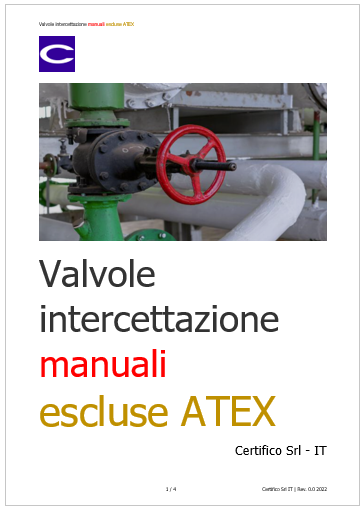Valvole di intercettazione manuali sono escluse ATEX
| ID 18870 | | Visite: 2154 | Documenti Riservati Marcatura CE | Permalink: https://www.certifico.com/id/18870 |
Valvole di intercettazione azionate manualmente non rientrano in Direttiva ATEX Prodotti
ID 18870 | 05.02.2023 / Scheda allegata
La Commissione europea ha nuovamente precisato che le valvole di intercettazione azionate manualmente non possono essere dichiarate ATEX, anche in relazione a posizioni difformi in merito di Costruttori di valvole.
Infatti, nelle Linee guida applicative della direttiva 2014/34/UE (4rd Edition November 2022), è ribadito (come nelle altre guide già emanate) che le valvole di intercettazione azionate manualmente sono escluse dal campo di applicazione della Direttiva ATEX Prodotti (Direttiva 2014/34/UE), infatti al § 38 è riportato:
...
§ 38 Examples of equipment not covered by Directive 2014/34/EU
Simple products
For "simple" electrical products, European harmonised standards provide a good basis to assess the effectiveness of electrical ignition source and, consequently, to determine whether or not these can be considered effective or not. In general, many "simple" mechanical products do not fall under the scope of Directive 2014/34/EU as they do not have their own source of ignition (see section § 41 on "Own" ignition source).
Examples without their own source of ignition are hand tools such as hammers, spanners, saws and ladders (see also the "Borderline list - ATEX products", pages 225-228).
Other examples that in most cases have no potential ignition source are given below.
However, the manufacturer will need to consider each item in turn with respect to potential ignition hazard to consider whether Directive 2014/34/EU applies:
- clockwork time pieces; mechanical camera shutters (metallic);
- pressure relief valves, self-closing doors;
- equipment moved only by human power, a hand operated pump, hand powered lifting equipment, hand-operated valves.
The issue of hand-operated valves has also been discussed. Given that these will move slowly, with no possibility of forming hot surfaces (as discussed in section § 42 on non-electrical equipment) they are not in scope of the Directive. Some designs incorporate polymeric parts, which could become charged, but this is no different from plastic pipes. Given that it is clear that the latter is outside of the scope of Directive 2014/34/EU it has been accepted that such valves do not fall within scope.
Some manufacturers have argued that their valves are specially adapted for ATEX, in that they have either selected more conductive polymers, or taken steps to ensure that no metal parts could become charged because they are unearthed. Other manufacturers state that all their valves meet this requirement simply by the way they are constructed, and they see no distinction from valves used to process nonflammable materials.
To avoid confusion between those who claim correctly that their valves have no source of ignition, and are out of scope, and those who claim that they have done some very simple design change and wish to claim that their valves are now category 2 or even 1, it has been agreed that valves having characteristics as described above are out of scope.
Nevertheless, where potentially flammable atmospheres exist, users must always consider the electrostatic ignition risks.
Installation
Installation is an entity which is made from parts previously considered separately but which are only put together at the point of application. They are different from assemblies which comprise parts previously considered separately, interconnected to create a combined product or assembly, to be placed on the market and/or put into service as a single functional unit (see section § 44 on combined equipment (assemblies)).
The ATEX Directive 2014/34/EU does not regulate the process of installation. Installing such (already ATEX-compliant) equipment at the end-user premises or under his responsibility will generally be subject to legal requirements either from the "workplace" directives (see footnote 7 in the "Introduction") or the domestic legislation of the Member States. However, the question is frequently asked to distinguish between the responsibilities of manufacturers, building a piece of equipment or an assembly under the ATEX Directive 2014/34/EU and those responsibilities of an end user, buying in equipment parts to build an installation.
(One might use the analogy of the difference between the manufacturing a discreet piece of equipment which can be placed on the market, such as a television – under the Low Voltage Directive 2014/35/EU, see section § 232 –, and equipping a house with all its utilities built into which a range of products will be installed and connected, this would clearly be an installation and come under the "workplace" Directive 89/391/EEC or other directives concerning workplace safety.)
A common situation is that pieces of already ATEX-compliant equipment are placed on the market independently by one or more manufacturer(s), and are not placed on the market by a single legal person as a single functional unit (as described in section § 44 on combined equipment (assemblies) which are fully specified configuration of parts). Combining such equipment and installing at the user's premises is not considered as manufacturing and thus does not result in equipment; the result of such an operation is an installation and is outside the scope of Directive 2014/34/EU.
The installer has to ensure that the initially compliant pieces of equipment still comply when they are taken into service. For that reason he has to carefully follow all installation instructions of the manufacturers. The Directive does not regulate the process of installation. Installing of ATEX-compliant equipment will generally be subject to legal requirements of the Member States. An example could be instrumentation consisting of a sensor, a transmitter, a Zener barrier and a power supply if provided by several different manufacturers installed under the responsibility of the user. It is understood that there is not always a clear line between an installation and an assembly. For assemblies and installations the responsibilities will either fall on the person who places the assembly on the market, or the end-user. Each must draw up a technical file setting out how they have complied with the relevant legislation. Much of the technical content will be the same. The result, this is to say, the installation of equipment in a plant, will usually not to be a "product" under the ATEX Directive 2014/34/EU if:
- the end-user, or an installer purchases parts (including ATEX equipment and installation materials) from different manufacturers and they are installed under his responsibility after a full risk assessment has been undertaken;
- the user carries out a whole series of different processes requiring the integration of ATEX-compliant equipment and parts on site, and they are installed according to a unique layout;
- the end-user commissions the building of parts of his installation off-site, which may be unique, but certainly not a production run, and which is done under his direct responsibility, or indirectly through a contractor, working under contract to him;
- commissioning tests or adjustments are needed once the plant is built and are carried out under the final responsibility of the end user.
...
§ 41 "Own" ignition source
A defining element of equipment in the sense of the Directive is that it has to have its own potential source of ignition.
Potential sources of ignition could be: electric sparks, arcs and flashes, electrostatic discharges, electromagnetic waves, ionising radiation, hot surfaces, flames and hot gases, mechanically generated sparks, optical radiation, chemical flame initiation, compression.
...
Vedi Linee guida ATEX Prodotti 2022
...
segue in allegato
Collegati
| Descrizione | Livello | Dimensione | Downloads | |
|---|---|---|---|---|
| Valvole di intercettazione manuali sono escluse ATEX Rev. 00 2023.pdf Certifico Srl - Rev. 0.0 2023 |
158 kB | 101 |
Tags: Marcatura CE Direttiva ATEX Prodotti Abbonati Marcatura CE













































